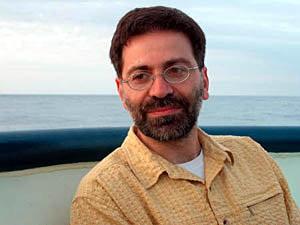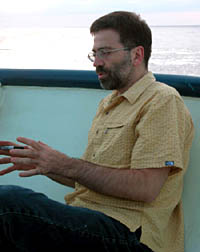Interviews: Interview with Dr. Diego Fernandez
 Dr. Diego Fernandez is a scientist on Expedition 7. He is a researcher at
the California Institute of Technology. Originally from Buenos Aires, Argentina, Diego came to the U.S. two years ago when his wife, also a chemist, got a job here. He says he intends to return to his own country soon, but for now he’s enjoying life in the states. Dr. Diego Fernandez is a scientist on Expedition 7. He is a researcher at
the California Institute of Technology. Originally from Buenos Aires, Argentina, Diego came to the U.S. two years ago when his wife, also a chemist, got a job here. He says he intends to return to his own country soon, but for now he’s enjoying life in the states.
�
Question: What’s
your earliest memory of being interested in chemistry?
Diego: Oh, when I was four or five, I think. I would play with test
tubes, doing experiments with tadpoles and little fish. I used to try to make
dyes by extracting colors from plants. I remember smells very well. Like, I had
a large jasmine on our patio, and I remember wanting to extract that smell. When
I was five or six, my sister and I tried making wine from grapes.
 |
 |
Question: Wow.
So, what did you do about your interest, when you got to school?
Diego: I just started taking classes in these things: biology, chemistry.
In Argentina, we don’t really have college the way it exists in the U.S.
You pretty much go from high school directly to university. So, you start intensive
study in your chosen subject earlier than in this country. You get a degree
that puts you on the road to a PhD. I got my degree at the University of Buenos
Aires, and then I taught there for seven years.
Question: When did you start to narrow your focus within chemistry?
Diego: Chemistry is really broad. Really, it’s everything.
There’s biochemistry, chemical engineering and chemistry in industry,
analytical chemistry. I prefer science that focuses on natural processes, including
man. Rather than theory. So I like this new adventure of oceanography.
Question: Why do you call it an adventure?
Diego: Partly because the chemistry I’ve done in the past
has been very different from this, and anything new is an adventure. I’m
finding myself drawn to earth science. And because of things like this cruise.
It’s a very different kind of way to do science. I’m used to the
laboratory.
Question: Do you see yourself going on
a lot more cruises?
Diego: (Laughs) I don’t know. The first week was hard, with
seasickness, and all the bad weather. And this feeling of being somewhat trapped
out here. But a lot of people have told me that after your first time, the
other times get much easier. So, we’ll see.
Question: What do you like about the laboratory?
Diego: I’m happy with tools. Give me tools and I can do anything!
Actually, my expertise will come into a play a lot more after we return to
CalTech with all these specimens we collect out here. We have a machine with
a very long name: The multi-collector inductively-coupled plasma mass spectrometer.
MC-ICP-MS. It’s what we use to do the very high-precision work necessary
to make sense of what we find.
Basically, you have a heating coil, like the one in an oven but much hotter.
It heats up to 8,000 Kelvin, and it breaks everything you put in it into atoms.
Once you have the atoms, you separate them using electric and magnetic fields,
and you count them. This can tell you the temperature of the ocean where you
found it, as well as the age. That’s why we’re out here.
[Back
to top]
| 

